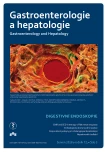A tumorous atrioesophageal fistula as an unusual cause of septicemia
Authors:
T. Fislová 1; R. Keil 1; J. Masopust 1; M. Grega 2
Authors‘ workplace:
Interní klinika 2. LF UK a FN Motol, Praha 2 Ústav patologie a molekulární medicíny
2. LF UK a FN Motol, Praha
1
Published in:
Gastroent Hepatol 2018; 72(3): 260-263
Category:
doi:
https://doi.org/10.14735/amgh2018csgh.info06
Overview
A 70-year-old male admitted to an emergency ward was examined for signs of sepsis. He complained of suffering from epigastralgia, food stagnation sensations, absence of appetite, and severe weight loss for several months. Elevation of inflammatory markers, dehydration, an ion imbalance, and microcytic anemia were found. The cause of sepsis was not revealed by abdominal ultrasonography, abdominal and chest X-rays, and abdominal, thoracic, and pelvic computer tomography. Transesophageal echocardiography was planned to rule out infectious endocarditis; however, gastroscopy was performed as a first-line examination. Blood was observed in the distal esophagus and stomach throughout this procedure. Refractory shock occurred during the examination, followed by unsuccessful cardiopulmonary resuscitation. Esophageal adenocarcinoma with an atrioesophageal fistula was found on autopsy, which was the cause of endocarditis and septic emboli in the systemic circulation. Installation of the nasogastric probe and air insufflation at the beginning of the gastroscopic examination likely caused the release of masses that originally filled the fistula, leading to massive bleeding and refractory hemorrhagic shock.
Key words:
esophageal neoplasms – fistula – sepsis
The authors declare they have no potential conflicts of interest concerning drugs, products, or services used in the study.
The Editorial Board declares that the manuscript met the ICMJE „uniform requirements“ for biomedical papers.
Submitted: 8. 2. 2018
Accepted: 5. 3. 2018
Sources
1. Magnusková S, Kollárova H, Kamarád V et al. Dvojí tvář rakoviny jícnu – epidemiologie a etiologie. Gastroent Hepatol 2011; 65 (5): 255–263.
2. Shah S, Saum K, Greenwald BD et al. Esophagopericardial fistula arising from Barrett‘s esophagus. Am J Gastroenterol 1998; 93 (3): 465–467.
3. Ali F, Mostafa A, Charachon A et al. Multidisciplinary therapy of a large esophago-pericardial fistula arising from Barrett‘s esophagus. Ann Thorac Surg 2008; 86 (5): 1690–1693. doi: 10.1016/j.athoracsur.2008.03.023.
Labels
Paediatric gastroenterology Gastroenterology and hepatology SurgeryArticle was published in
Gastroenterology and Hepatology

2018 Issue 3
- Metamizole at a Glance and in Practice – Effective Non-Opioid Analgesic for All Ages
- Possibilities of Using Metamizole in the Treatment of Acute Primary Headaches
- Metamizole vs. Tramadol in Postoperative Analgesia
- The Importance of Limosilactobacillus reuteri in Administration to Diabetics with Gingivitis
Most read in this issue
- Vistaprep – the standard of bowel preparation before colonoscopy
- A tumorous atrioesophageal fistula as an unusual cause of septicemia
- Is Amanita phalloides poisoning still a problem?
- Experience in the treatment of severe bleeding in Crohn’s disease with anti-TNF therapy
